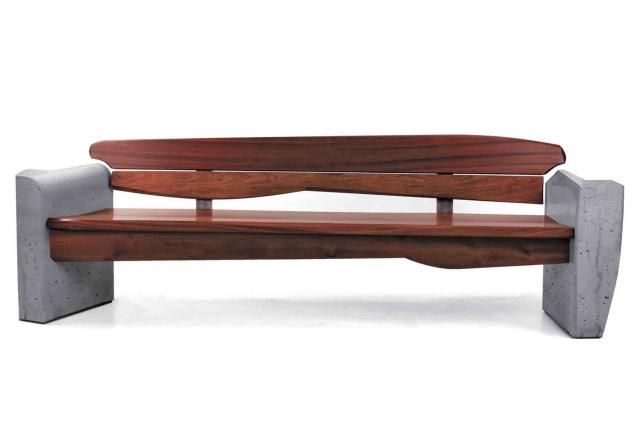Art and Craft That Flaunts Convention

Deep in the woods near Crooked Pond in Sag Harbor, where he lives and works, Nico Yektai took a break recently to consider what had given rise to his creative bent. “The idea that furniture could be just like sculpture, or painting, seemed very natural to me,” the artist-craftsman said. He referred again and again to the towering influence of his father, the Abstract Expressionist Manoucher Yektai. Mr. Yektai works primarily in wood, which was leaned against or stacked amid power tools and work tables, and uses concrete, too. His signed pieces have been exhibited at the Parrish Art Museum and Guild Hall, are sold at Mecox Gardens in Southampton, and, this summer, can be seen in an outdoor furniture exhibit at LongHouse Reserve in East Hampton. The elder Mr. Yektai, born in Tehran and educated there and in Paris and New York, “puts a lot of energy and immediacy in his painting,” his son said. “He paints with broad, palette-knife strokes. I grew up watching him construct these paintings — actual, recognizable subject matter, but building it up with these gestural strokes, one element at a time. Of course, within each stroke, there was a lot of unknown as to where the paint was rolling off the palette knife, so there was room for accidents and, certainly, spontaneity. Something unexpected happened and he reacted to it, and the whole composition evolved in a different way.” The younger Mr. Yektai was also born in Iran, during his parents’ yearlong visit to the place of his father’s birth. He grew up in New York City, but “this place” — the South Fork — “was in my blood from my childhood. We were out here every weekend, year-round.” Here, as a youth, he built tree houses “with wood pilfered from Norman Jaffe construction sites — with his permission!” he said, recalling the noted architect. The father recognized the son’s creative inclinations, and together they built rudimentary furniture for the family. As they worked, “We’d have profound conversations about furniture,” Mr. Yektai said. After undergraduate work in art history, Mr. Yektai went to the School of American Craft at the Rochester Institute of Technology, “a fabulous program for woodworking and furniture design.” There, he said, “I became the student I should have been the whole time. I was really motivated and inspired, soaked up as much as I could, and left with a solid technical foundation.” Once the technical knowledge and conventions of the discipline were gained, he said, “everything else fell into place, and I’ve spent the rest of my time violating those things.” Indeed, Mr. Yektai’s work seems to flaunt convention, fusing creativity and utility seamlessly in every piece. Violating custom, he said, “starts with the ever-so-simple notion that ‘two pieces of wood should be glued together to blend into one.’ You go to a lot of trouble picking the grains so when you lay it together the transition melds into one. What I immediately did was mismatch the grain, and move the glue joint to show it — shift the piece and mismatch it so that each board stood out and had its own identity. Those components gave me something to move and react against, and react against again, and do something else, and before you know it, the piece is evolving as I build it. That’s a direct evolution of what I saw my dad doing with those palette-knife brush strokes.” All of his work, he said, is nonconforming, “where the structural elements become the decoration. They are essential to the function, which I like to satisfy, but they become decorative.” As with his tables and benches, Mr. Yektai’s wall consoles are one-of-a-kind combinations of doors and drawers that open “in all funky, different directions,” he said. More recently, his work has moved to the outdoors. “People were complaining, ‘That bench is huge, it can’t fit in my house.’ I got tired of hearing that, so I started making some outdoor pieces. Much to my surprise, it opened up some great possibilities.” He applies the same design philosophy to concrete as he does to wood: “I found a way to enliven it with spontaneity.” Lately, he has been developing more pieces for Mecox Gardens, which he describes as “a little bit out of what I normally do. They’re very well-designed pieces that will still have that sculptural quality I chase after, but are a little easier to place.” A boundary-pushing artist as a father and an upbringing in the rural, natural setting of the South Fork are no small elements among the forces that shaped him, but creativity is a family affair: Mr. Yektai’s mother, Niki Yektai, has written and illustrated many children’s books. “What I’ve learned from my parents together, in terms of the way they raised me around art, is a huge part of it,” Mr. Yektai said. “All these things set me on a course with that rudder that I got from my dad, which is to be sincere and serious, and to try for something original.”
